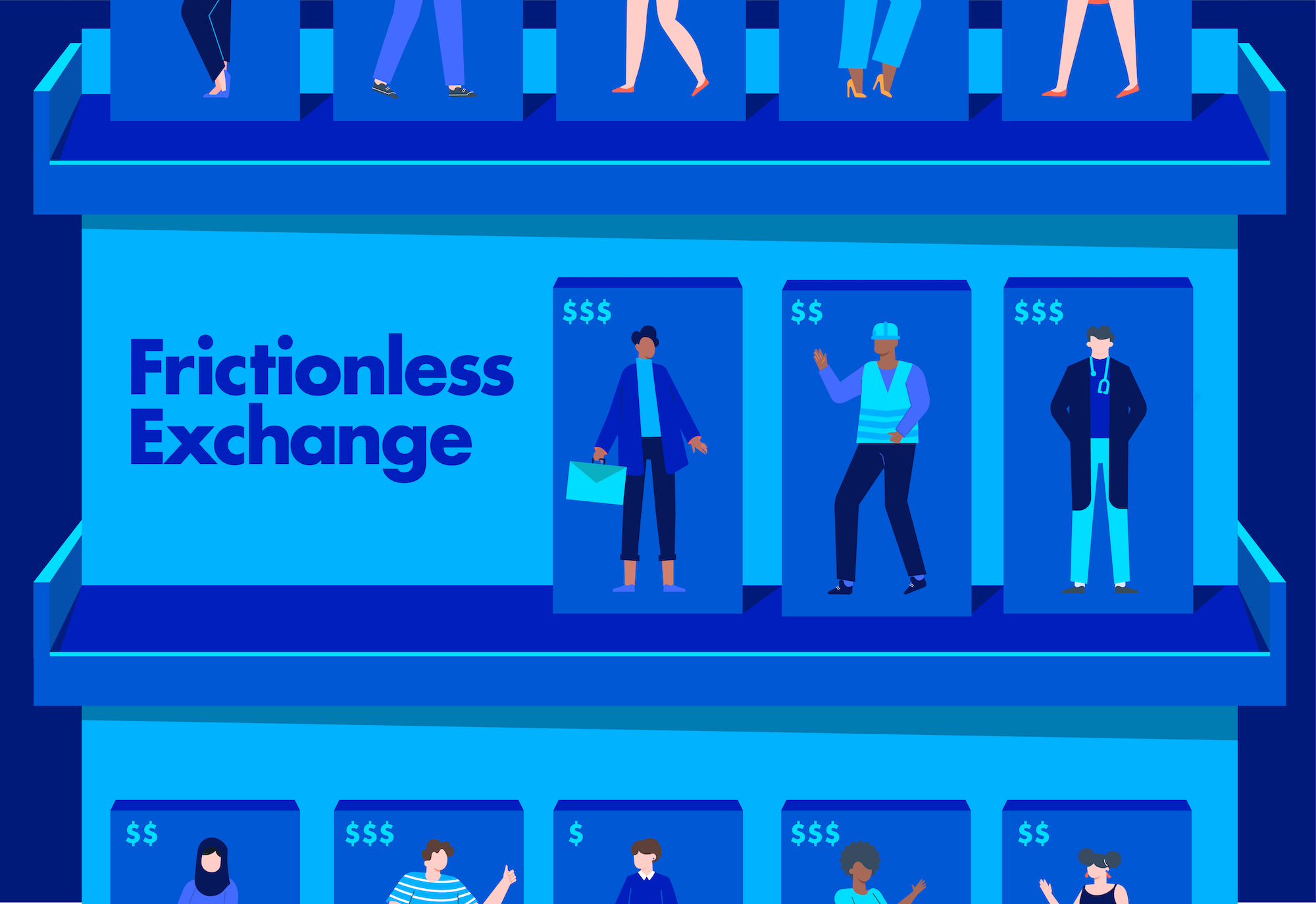

Gig workers deserve fair labor markets that private platforms cannot provide.
RECOMMENDED READING
I met Kayla in 2018, when she was begging for gas money outside a 7-Eleven in Los Angeles. For $5, she explained why. An unemployed Ohioan, she had moved to L.A. with her six-year-old son after a cousin who managed a franchise restaurant offered her a job. But it was algorithmically scheduled and proved to be nothing more than ad-hoc hours at short notice whenever tables were likely to fill. Her extended family, who promised to look after her boy, were equally at the mercy of uncertain employment and struggled to fill child-care responsibilities.
By seeking to better herself with a move, Kayla had unwittingly joined the then-36% of Americans reliant on gig work. As well as the spasmodic waitressing, she had signed up on platforms to do deliveries and clean houses, but bookings were erratic and paid poorly. She had just enough gas money to get through another day traveling between hoped-for gigs and uncertain parenting.
There has been wide coverage of hardships faced by members of the “Precariat” like Kayla. When I met her, I was already two years into a philanthropically funded mission to help American policymakers, officials, and donors understand the phenomenon and potential solutions. Diverse attempts at regulation have not slowed the growth of gig work or done much to improve its working conditions. Like it or not, gig work is here to stay.
Those committed to self-reliance, reward for hard work, and the primacy of markets should be aghast at the new one-sided infrastructure that has emerged for this kind of flexible economic activity. The challenge before us is to understand the novelty of the digitally enabled gig economy and to formulate a proportionate policy response.
9-to-5 Decline
One of the main barriers to grappling with the gig economy is what I’ve termed the “Regularocracy” perspective. This says that 9-to-5 jobs should be everyone’s default mode of income generation and relatively easy to expand if citizens just have the right skills. The view is understandable. Those who tend to hold it have typically progressed from full-time education to one regular-hours job after another, perhaps with a smattering of unemployment and the occasional side gig. Naturally, the idea of family breadwinners foraging for technology-mediated work every day can seem incomprehensible, viscerally disturbing, and peripheral—a problem to be stamped out.
Regularocratic thinking dominates today’s labor market policy. Federal performance metrics railroad public agencies around the U.S. toward job-creation efforts, not supporting those in the reality of today’s shifting-sands labor markets. But analysis in the New York Times, Washington Post, Los Angeles Times, and elsewhere shows that what government counts as a job, or as unemployment, is too often a gray zone in between—just endless turbulent bouts of work. The potential of public agencies to improve gig-work markets is explored only on the fringes.
“Naturally, the idea of family breadwinners foraging for technology-mediated work every day can seem incomprehensible, viscerally disturbing, and peripheral—a problem to be stamped out.”
But freelancers are projected to make up most of the American workforce by 2023. In the wake of COVID-19, a majority of Americans could find themselves working outside a steady job. Lower-skilled, 9-to-5 positions will take longer to open and to be filled—if ever.
Moreover, many American job seekers are unable to take on a 9-to-5 job. About 20% of adults have a medical condition, caregiving or parenting commitments, or studying patterns that change day to day. Not blessed with 40 hours available to work each week, these already hard-pressed citizens fall outside government or philanthropic job-creation efforts and instead seek fluid work on digitally mediated gig platforms.
Marking Markets
To better understand the challenges that gig workers face, we must focus on the mechanics of labor markets and the digital technologies that now mediate them. The quality of the markets that they use is pivotal. Someone in a 9-to-5 job will typically enter the labor market every few years, when it’s time to find a new job. But gig workers can be in and out of the market several times a day in search of another assignment.
We should not treat “markets” as a broad concept but instead see each individual platform as an apparatus offering a menu of features. We must evaluate any exchange—be it for warehouse workers, beauticians, bike rentals, or peer-to-peer lending—by the value that it gives each seller of the relevant resource. Broadly, there are five aspects to assess in any market:
- Liquidity: The best market imaginable will be used by 100% of the buyers of the resource being traded, each purchasing constantly.
- Breadth: Platforms for dog care—as one example—are well funded. But few people can only look after neighbors’ pooches. Most of us have diverse skills and experience. Ideally, sellers will have a market that allows them to develop all their skills and assets—thereby maximizing earnings—in one coherent exchange.
- Charges: The lower the platform operator’s take, the higher each seller’s take-home pay.
- Features: The most useful market will share granular data on patterns of supply, demand, and pricing with sellers. It will enable nuanced matching with buyers, perhaps fostering ongoing relationships, make supportive interventions uniquely cost-effective, and give sellers full control over their pricing.
- Governance: Sellers in a fair market know that they are treated neutrally, operators are accountable, processes are transparent, and the platform itself is robust and unlikely to fail.
By these dimensions, today’s digitally enabled gig markets are terrible.
“We should not treat ‘markets’ as a broad concept but instead see each individual platform as an apparatus offering a menu of features.”
Consumer services like Uber are just the tip of an iceberg. Platforms like Kronos that run monopsonistic labor markets for corporate employers are far more influential. But Uber serves as the prime example, as its record-breaking valuations have ensured unusual scrutiny and reporting.
By the time I met Kayla, Uber had been caught slashing worker pay. (Its rival Lyft had cut wages earlier.) In 2017 alone, Uber was fined for overstating drivers’ earnings potential, investigated by the FBI for slanting its market toward undermining Lyft, and caught systematically misleading regulators. Uber typically retains a third of passengers’ fees as commission. It is easy to underestimate the ruthlessness, sophistication, and resources of the companies that provide today’s labor-market infrastructure.
Assessing any inadequacies in the markets accessible to fluid work-seekers requires us to have a benchmark. What would a healthy version of digitally mediated markets look like?
Consider Wall Street. When new technologies for information retrieval, dissecting data, payment transfers, graphic displays, and back-office processes emerged, financial institutions built themselves markets that come as close as possible to perfectly frictionless. A trader at Goldman Sachs or Citi uses software that seamlessly identifies and executes opportunities across multiple exchanges, forces down overheads, and minimizes transaction risk while proactively combing for openings to suit current objectives.
These modern markets transformed finance. It is hard to see how financial capitalism could have exploded if trades had continued to be conducted through phone calls, open outcry, or back-and-forth emails. And exponential growth in financial trading seems inconceivable if the exchanges used were as biased, controlling, limited in options, and income-extracting as those that many low-income work-seekers rely on every day.
“It is easy to underestimate the ruthlessness, sophistication, and resources of the companies that provide today’s labor-market infrastructure.”
Wall Street’s hyper-markets didn’t spontaneously emerge. Big banks used their clout to force multiple exchanges to become interoperable with proprietary trading software. That created huge breadth, and additional asset classes gave these systems depth. In-built comparison shopping between exchanges ensured ruthless pressure on transaction charges. That merited investment in functionality for sellers, including extraordinary feats of data processing. To ensure robustness, governments enabled state-owned clearinghouses, NRSROs, the National Market System, Fedwire, and other solid underpinning.
Kayla and her tens of millions of peers are too disparate and lack the clout to create the markets that they need. Their life chances depend on fair, deep markets with tools enabling informed decisions, but they have little choice over the markets that they use. They have to go where the buyers are—usually, the platforms offering lower prices and instant service from interchangeable, tightly controlled, sellers.
Market Farces
The private sector alone can’t solve the inequality of markets. Any company launching a new exchange for any resource must attract buyers away from existing markets. Once buyers come over, sellers must follow. This basic dynamic shapes the business model for new markets based on outspending competitors to raise buyer awareness. Typically, that’s done by buying costly online advertising to show up alongside searches such as “Temporary Secretaries, Chicago.” The spending required is viable only with a niche market for the new platform.
This intensity of competition for buyers drives Uber to subsidize its customers. Up to 60% of prices during its growth phase in any area can be discounted. On top of unrealistically low prices, buyers like an oversupplied market. The reason an Uber ride usually turns up so quickly is that there are more drivers prowling for bookings in any locality than there is work. Maintaining that mis-equilibrium requires opacity of data so that the supply side can’t act in its best interests.
But fair opportunity for gig workers requires broad, balanced, informed, low-charge, and transparent markets. There have, of course, been attempts to launch these, but they haven’t come close to the goliath platforms built on fierce buyer attraction.
“Fair opportunity for gig workers requires broad, balanced, informed, low-charge, and transparent markets.”
My encounter with Kayla was timely in this regard. I was in California advising public agencies how they might support people working outside traditional employment. I had run British government programs that created a market for anyone seeking gig work. Unlike the for-profit labor systems shaping Kayla’s prospects, our sophisticated platform was built around protections, control, stability, and progression for work-seekers.
Government has enormous leverage to initiate the best markets now possible across the base of its economy. As one example, public agencies are—directly or indirectly—the biggest buyers of many types of labor.
It may be time to adopt a “Modern Markets for All” policy in which public agencies launch better platforms for ad-hoc economic activity. This is not radical. Depression-era legislation established public labor exchanges, now rebadged “American Job Centers,” as an alternative to commercial staffing agencies. Every U.S. state offers an all-sectors job-matching platform for those who feel underserved by for-profit job boards.
“Government has enormous leverage to initiate the best markets now possible across the base of its economy.”
Government’s market-moving power could underpin a version of the concession model routinely used to deliver official lotteries, complex civil engineering programs, and transportation services. Government could reward an operator who undertakes to fund, build, and run a new, empowering set of open markets by making them the favored channel for public spending. That should prime the pump for wider activity. Market operators retain a small—but ongoing—cut of the economic activity generated but must commit to legally enforced controls ensuring a stable, fair, and transparent market.
Imagine a hugely sophisticated platform seamlessly trading across thousands of sectors in which regular citizens and local businesses sell. There would be no restraint on alternative platforms, and taxpayers would fund only the transparent concession award process.
If well executed, a policy like this could give individuals like Kayla a surge in opportunity, data, support, protections, and earnings. A small intervention like this, creating an additional choice of markets, could have a wider impact than regulation of aggressive platforms. Perhaps we should try giving markets a chance to address today’s soaring inequality and the accompanying public anger before government-imposed redistribution becomes inevitable.
Recommended Reading
Is A Child Allowance Pro-Work for Poor Parents?
An injection of cash to poor families might be less of a handout and more of a hand up, acting as much-needed capital for families by allowing them to afford the things necessary to stay employed.
Should Congress Extend the $600 Federal Unemployment Benefit?
In March as Ohio began to shut down, Emily—a thirtysomething mom who asked that I not use her real name—worried about her family, her neighbors, and especially the elderly. She posted on her town’s Facebook page offering to grocery shop for those unable to go to the store, or to share a meal with anyone who might be hungry, saying that she’d feed them whatever she could out of her own kitchen.
Industrial Policy Must Account for Worker Attitudes
n a recent post about the relationship between family trends and the skills gap I noted that for some of the young adults my husband David and I interviewed in southwestern Ohio, trauma and addiction make it difficult to take advantage of the employment opportunities that do exist.













